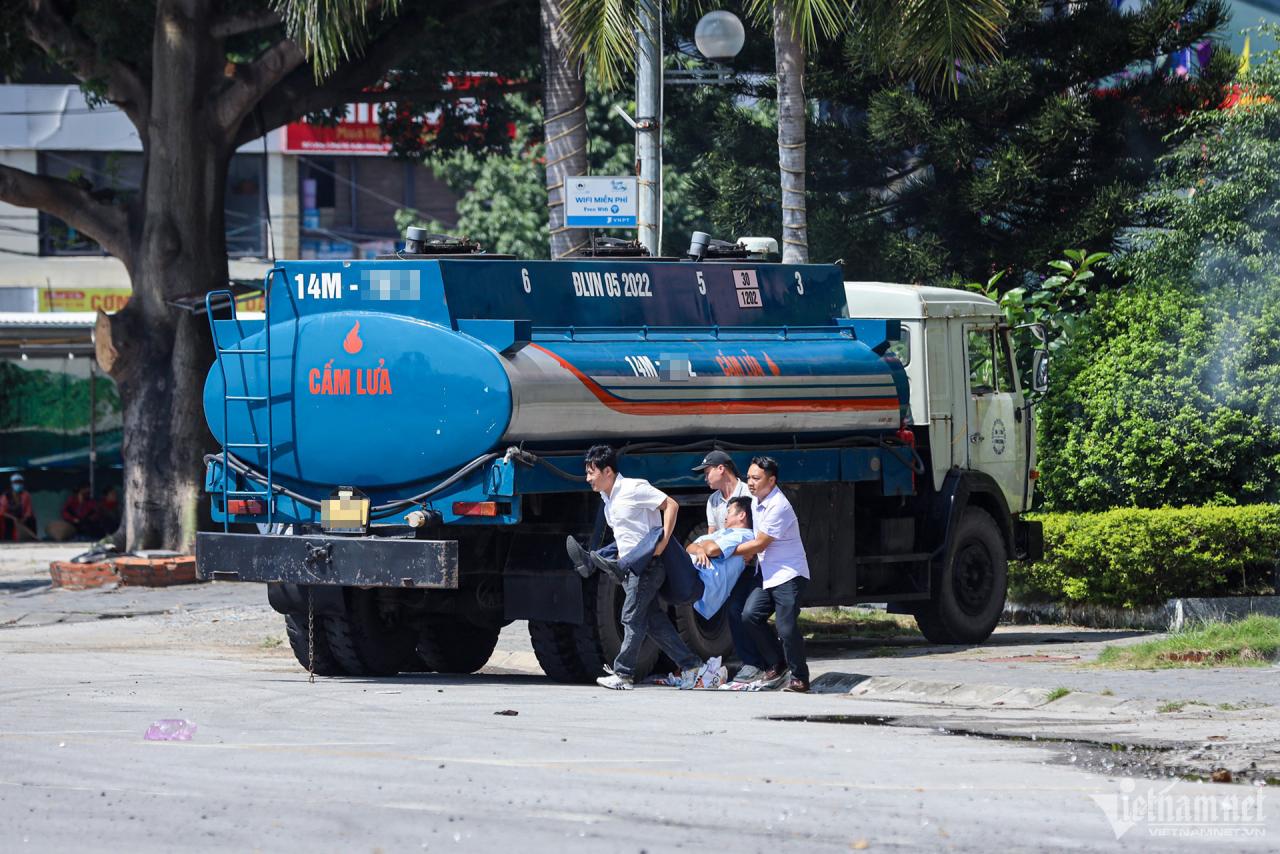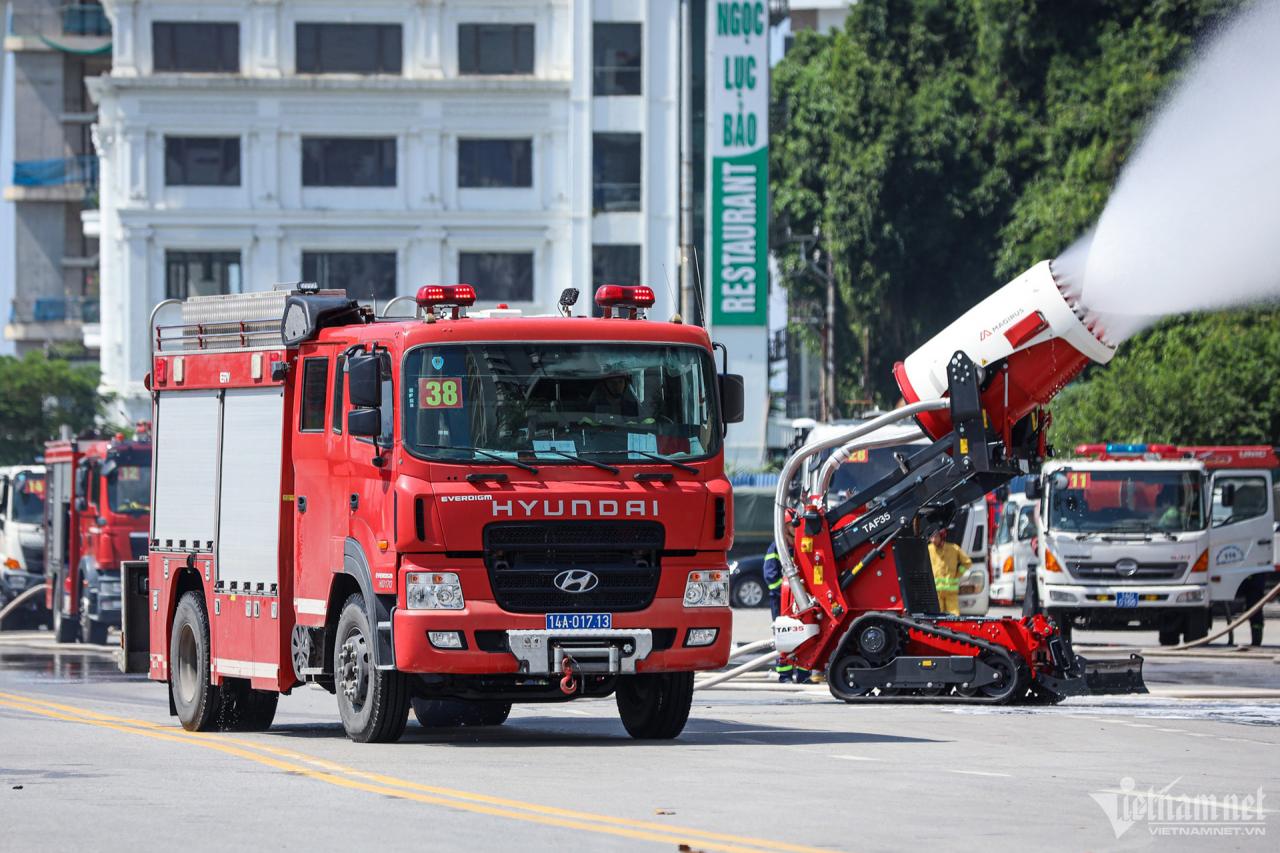{"article":{"id":"2219682","title":"Ensuring fire and explosion safety for fuel tankers","description":"Gasoline and oil are classified as commodities with a high risk of fire and explosion. Therefore, during the transportation process, ensuring fire safety must always be a top priority.","contentObject":"
On November 25, a fire broke out involving a fuel tanker truck on Nguyen Van Linh Street (HCMC) heading towards National Highway 1.
\nAccording to witnesses, the car leaked fuel and caught fire. Seeing this, passersby shouted and warned the driver to pull over to the side of the road.
\nUpon receiving the news, the authorities arrived at the scene and began extinguishing the fire. Although the damage was not too severe, the fire still injured the driver while approaching the fire to extinguish it.
\nPreviously, on May 16, a gasoline tanker traveling on National Highway 14 from Gia Lai to Kon Tum suddenly had a tire blowout and caught fire. The fire then spread to other areas. Fortunately, there was no gasoline left in the tanker at that time, so the estimated damage was only about 20 million VND.
\nA notable fire involving a fuel tanker occurred on February 3 in Nha Be District (HCMC). Accordingly, the tanker carrying 23,000 liters of gasoline was parked on the roadside when it suddenly caught fire. The fire then spread to 3 nearby houses due to fuel leaking from the tanker truck and spreading around.
\nPeople used mini fire extinguishers to put out the fire but failed. It took the fire department nearly an hour to control the fire. The incident burned down many properties in 3 houses and partially burned the tanker truck.
\nAccording to the representative of the Fire Prevention and Rescue Police Department, fuel tankers have different characteristics compared to vehicles carrying other types of goods. For example, when changing direction or braking suddenly, if the vehicle is full of fuel, the fuel may expand, making it unsafe to transport. Meanwhile, if the vehicle is carrying too little fuel compared to its capacity, it can also cause an unsafe situation.
\nTherefore, the representative of the Fire Prevention and Rescue Police Department recommends that operators and tanker truck drivers must strictly follow the procedures and regulations when operating this special type of vehicle.
\nAccordingly, there must be regulations, prohibition signs, signs, and instructions according to fire prevention standards. Fuel trucks must have the symbol and warning "NO FIRE" according to the regulations stated in Circular No. 149/2020/TT-BCA.
\nManagement units, vehicle owners and drivers need to ensure that the electrical system, fuel and equipment on the vehicle do not generate sparks...
\nVehicles must also be equipped with fire-fighting equipment as prescribed, such as at least 2 portable fire extinguishers (4kg or more), pliers, fire-proof flashlights, hammers, etc. Vehicles with a load capacity of 5 tons or more must be equipped with at least 3 fire extinguishers.
\nThe representative of the Fire Prevention and Rescue Police Department also stated that the engine of the fuel tanker must be isolated from the cargo compartment by non-flammable materials or a buffer chamber. The exhaust pipe of the engine must also be carefully covered to ensure safety against fire and explosion.
\nTank trucks must also have grounding chains to convert all electrical charges into electric current, transmitted to the ground to neutralize the electricity, avoiding fire and explosion.
","displayType":1,"options":0,"category":{"name":"Topic content","detailUrl":"/noi-dung-chuyen-de","wikiCategoryDetailUrl":"/ho-so/noi-dung-chuyen-de","subIds":["000041"],"fullAvatarUrl":"","fullFacebookShareUrl":""},"displayTypeToInt":1,"detailUrl":"/dam-bao-an-toan-chay-no-cho-xe-bon-cho-nhien-lieu-2219682.html","fullAvatarUrl":"https://static-images.vnncdn.net/files/publish/2023/11/30/dam-bao-an-toan -chay-no-cho-xe-bon-cho-nhien-lieu-1459.jpg","fullAvatarFbUrl":"https://static-images.vnncdn.net/files/publish/2023/11/30/dam-bao-an-toan-chay-no-cho-xe-bon-cho-nhien-lieu-1460.jpg","updatedDate":"2023-11-30T21:28:10","isHiddenDescription":"","publishDateDisplay":"11/30/2023","hasCover":false},"articlesSameCategory":[{"id":"2219702","title":"Request "Promoting the role of the '4 on-site' force in fire prevention and fighting","description":"In addition to strengthening training on fire prevention and fighting techniques for specialized forces, Hanoi City also promotes the role of the '4 on-site' force such as civil defense and grassroots fire prevention and fighting.","displayType":1,"category":{"name":"Topic content","detailUrl":"/noi-dung-chuyen-de","wikiCategoryDetailUrl":"/ho-so/noi-dung-chuyen-de","subIds":["000041"],"fullAvatarUrl":"","fullFacebookShareUrl":""},"displayTypeToInt":1,"detailUrl":"https://vietnamnet.vn/de-cao-vai-tro-luc-luong-4-tai-cho-trong-pccc-2219702.html","fullAvatarUrl":"https:/ /static-images.vnncdn.net/files/publish/2023/11/30/de-cao-vai-tro-luc-luong-4-tai-cho-trong-pccc-1450.jpeg","isFee":false,"priority":0,"zoneId":"","publishDate":"2023-11-30T21:25:51","option":0,"avatarIconPosition":0,"updatedDate":"0001-01-01T00:00:00","isPin":false},{"id":"2221332","title":"Western Tay Ninh province won the Vietnam Smart City Award 2023","description":"Tay Ninh province won the Vietnam Smart City Award 2023 in the category of Executive City, Smart Urban Area (IOC).","displayType":1,"category":{"name":"Topic content","detailUrl":"/noi-dung-chuyen-de","wikiCategoryDetailUrl":"/ho-so/noi-dung-chuyen-de","subIds":["000041"],"fullAvatarUrl":"","fullFacebookShareUrl":""},"displayTypeToInt":1,"detailUrl":"https://vietnamnet.vn/tay-ninh-dat-giai-thanh-pho-thong-minh-viet-nam-2023-2221332.html","fullAvatarUrl":"https: //static-images.vnncdn.net/files/publish/2023/11/30/tay-ninh-dat-giai-thanh-pho-thong-minh-viet-nam-2023-1390.png","isFee":false,"priority":0,"zoneId":"","publishDate":"2023-11-30T19:14:00","option":0,"avatarIconPosition":0,"updatedDate":"0001-01-01T00:00:00","isPin":false},{"id":"2220574","title":"Ha The Hanoi People's Committee has set a goal of completing the repair of existing fire prevention and fighting works by 2025.","description":"The Hanoi People's Committee has just issued a document to rectify districts that do not seriously implement the request for construction owners to repair existing fire prevention and fighting works.","displayType":1,"category":{"name":"Specialized content topic","detailUrl":"/noi-dung-chuyen-de","wikiCategoryDetailUrl":"/ho-so/noi-dung-chuyen-de","subIds":["000041"],"fullAvatarUrl":"","fullFacebookShareUrl":""},"displayTypeToInt":1,"detailUrl":"https://vietnamnet.vn/ha-noi-dat-muc-tieu-den-nam-2025-khac-phuc-xong-cong-trinh-ton-tai-pccc-2220574.html","fullAvatarUrl":"https: //static-images.vnncdn.net/files/publish/2023/11/30/ha-noi-dat-muc-tieu-den-nam-2025-khac-phuc-xong-cong-trinh-ton-tai-pccc-234.jpeg","isFee":false,"priority":0,"zoneId":"","publishDate":"2023-11-30T09:59:00","option":0,"avatarIconPosition":0,"updatedDate":"0001-01-01T00:00:00","isPin":false},{"id":"2209089","title":"Silver Bac Lieu strives to soon become the center of the country's shrimp industry","description":"Bac Lieu province currently has 3 main export products: shrimp, rice and salt. Of which, the main export product is shrimp - accounting for over 95% of the province's export turnover.","displayType":1,"category":{"name":"Specialized content topic","detailUrl":"/noi-dung-chuyen-de","wikiCategoryDetailUrl":"/ho-so/noi-dung-chuyen-de","subIds":["000041"],"fullAvatarUrl":"","fullFacebookShareUrl":""},"displayTypeToInt":1,"detailUrl":"https://vietnamnet.vn/bac-lieu-phan-dau-som-tro-thanh-trung-tam-nganh-cong-nghiep-tom-cua-ca-nuoc-2209089.html","fullAvatarUrl":"https ://static-images.vnncdn.net/files/publish/2023/11/1/bac-lieu-phan-dau-som-tro-thanh-trung-tam-nganh-cong-nghiep-tom-cua-ca-nuoc-119.png","isFee":false,"priority":0,"zoneId":"","publishDate":"2023-11-30T03:35:00","option":0,"avatarIconPosition":0,"updatedDate":"0001-01-01T00:00:00","isPin":false},{"id":"2220570","title":"Già "Assuming a fire broke out in a hospital with 4 people trapped inside, how did the fire department approach?","description":"Assuming the fire started from an electrical outlet in the meeting room on the 6th floor of the Viet Phap Hospital, quickly spreading to surrounding areas, potentially causing a fire to spread to the entire 6th floor area and 4 people were trapped inside.","displayType":1,"category":{"name":"Specialized content topic","detailUrl":"/noi-dung-chuyen-de","wikiCategoryDetailUrl":"/ho-so/noi-dung-chuyen-de","subIds":["000041"],"fullAvatarUrl":"","fullFacebookShareUrl":""},"displayTypeToInt":1,"detailUrl":"https://vietnamnet.vn/gia-dinh-chay-benh-vien-co-4-nguoi-dang-mac-ket-pccc-tiep-can-ra-sao-2220570.html","fullAvatarUrl":"https: //static-images.vnncdn.net/files/publish/2023/11/30/gia-dinh-chay-benh-vien-co-4-nguoi-dang-mac-ket-pccc-tiep-can-ra-sao-264.jpg","isFee":false,"priority":0,"zoneId":"","publishDate":"2023-11-29T19:26:00","option":0,"avatarIconPosition":0,"updatedDate":"0001-01-01T00:00:00","isPin":false},{"id":"2217425","title":"Electricity Smartphones support ethnic minority women in economic development","description":"Thanks to smartphones, audio-visual electronic devices and the internet, ethnic minorities in Lao Cai have learned to apply technology to agricultural production, learn economic models and sell online.","displayType":1,"category":{"name":"Specialized content topic","detailUrl":"/noi-dung-chuyen-de","wikiCategoryDetailUrl":"/ho-so/noi-dung-chuyen-de","subIds":["000041"],"fullAvatarUrl":"","fullFacebookShareUrl":""},"displayTypeToInt":1,"detailUrl":"https://vietnamnet.vn/dien-thoai-thong-minh-ho-tro-phu-nu-dan-toc-thieu-so-phat-trien-kinh-te-2217425.html","fullAvatarUr l":"https://static-images.vnncdn.net/files/publish/2023/11/28/399999130-3613690545542019-4747599412027560662-n-1-1139.jpg","isFee":false,"priority":0,"zoneI d":"","publishDate":"2023-11-28T17:44:51","option":0,"avatarIconPosition":0,"updatedDate":"0001-01-01T00:00:00","isPin":false},{"id":"2220683","title":"Publication Hanoi police train and check professional skills with fire prevention and rescue commanders","description":"Hanoi police have just opened a training course and periodically checked professional skills with leaders and commanders of the Fire Prevention and Rescue Police Department and the District, Town and City Police in charge of fire prevention and rescue work.","displayType":1,"category":{"name":"Specialized content topic","detailUrl":"/noi-dung-chuyen-de","wikiCategoryDetailUrl":"/ho-so/noi-dung-chuyen-de","subIds":["000041"],"fullAvatarUrl":"","fullFacebookShareUrl":""},"displayTypeToInt":1,"detailUrl":"https://vietnamnet.vn/cong-an-ha-noi-huan-luyen-kiem-tra-nghiep-vu-voi-chi-huy-pccc-cnch-2220683.html","fullAvatarUrl":"https: //static-images.vnncdn.net/files/publish/2023/11/30/cong-an-ha-noi-huan-luyen-kiem-tra-nghiep-vu-voi-chi-huy-pccccnch-278.jpeg","isFee":false,"priority":0,"zoneId":"","publishDate":"2023-11-28T08:33:00","option":0,"avatarIconPosition":0,"updatedDate":"0001-01-01T00:00:00","isPin":false},{"id":"2219952","title":"Increase "Strengthening information on policies to promote trade and investment between Vietnam and China","description":"The Ministry of Industry and Trade of Vietnam and the Embassy of Vietnam in China have coordinated with the China Trade Promotion Committee to organize the "Vietnam-China Trade and Investment Promotion Conference". ","displayType":1,"category":{"name":"Specialized content topic","detailUrl":"/noi-dung-chuyen-de","wikiCategoryDetailUrl":"/ho-so/noi-dung-chuyen-de","subIds":["000041"],"fullAvatarUrl":"","fullFacebookShareUrl":""},"displayTypeToInt":1,"detailUrl":"https://vietnamnet.vn/tang-cuong-thong-tin-ve-chinh-sach-thuc-day-kinh-te-thuong-mai-va-dau-tu-2219952.html","fullAvatarUrl":"https://stat ic-images.vnncdn.net/files/publish/2023/11/28/tang-cuong-thong-tin-ve-chinh-sach-thuc-day-kinh-te-thuong-mai-va-dau-tu-viet-trung-284.png","isFee":false,"priority":0,"zoneId":"","publishDate":"2023-11-27T19:26:00","option":0,"avatarIconPosition":0,"updatedDate":"0001-01-01T00:00:00","isPin":false},{"id":"2219968","title":"Development launched the Online Contest "Learning about Vietnam Border Law"","description":"The Border Guard Command has just launched the Online Contest "Learning about Vietnam Border Law".,"displayType":1,"category":{"name":"Topic content","detailUrl":"/noi-dung-chuyen-de","wikiCategoryDetailUrl":"/ho-so/noi-dung-chuyen-de","subIds":["000041"],"fullAvatarUrl":"","fullFacebookShareUrl":""},"displayTypeToInt":1,"detailUrl":"https://vietnamnet.vn/phat-dong-cuoc-thi-truc-tuyen-tim-hieu-luat-bien-phong-viet-nam-2219968.html","fullAvatarUrl":"https: //static-images.vnncdn.net/files/publish/2023/11/27/phat-dong-cuoc-thi-truc-tuyen-tim-hieu-luat-bien-phong-viet-nam-1442.png","isFee":false,"priority":0,"zoneId":"","publishDate":"2023-11-27T17:54:00","option":0,"avatarIconPosition":0,"updatedDate":"0001-01-01T00:00:00","isPin":false},{"id":"2219965","title":"Nearby 1 million downloads and about 250 thousand uses of VETC e-wallet","description":"At the end of April, VETC was officially licensed to provide intermediary payment services and e-wallets. Currently, there are nearly 1 million downloads and about 250 thousand uses of the wallet through upgrading operations on smartphones.","displayType":1,"category":{"name":"Specialized content topic","detailUrl":"/noi-dung-chuyen-de","wikiCategoryDetailUrl":"/ho-so/noi-dung-chuyen-de","subIds":["000041"],"fullAvatarUrl":"","fullFacebookShareUrl":""},"displayTypeToInt":1,"detailUrl":"https://vietnamnet.vn/gan-1-trieu-luot-tai-va-khoang-250-nghin-luot-su-dung-vi-dien-tu-vetc-2219965 .html","fullAvatarUrl":"https://static-images.vnncdn.net/files/publish/2023/11/29/thuphi-496.png","isFee":false,"priority":0,"zoneId":"","publishDate":"2023-11-27T16:43:00","option":0,"avatarIconPosition":0,"updatedDate":"0001-01-01T00:00:00","isPin":false},{"id":"2214322","title":"H'Mong village chief spends 2 years convincing villagers to do tourism","description":"Then Pa village located at the foot of Lung Cu flagpole has started providing accommodation and experiential tourism services for tourists in the past 2 months. Village chief Vang Sinh Lung previously spent nearly 2 years convincing villagers to change their economic model.","displayType":19,"category":{"name":"Specialized content topic","detailUrl":"/noi-dung-chuyen-de","wikiCategoryDetailUrl":"/ho-so/noi-dung-chuyen-de","subIds":["000041"],"fullAvatarUrl":"","fullFacebookShareUrl":""},"displayTypeToInt":19,"detailUrl":"https://vietnamnet.vn/truong-thon-nguoi-h-mong-danh-2-nam-thuyet-phuc-dan-ban-lam-du-lich-2214322.html","fullAvatarUrl":"https://static-images.vnncdn.net/files/publish/2023/11/27/t ruong-thon-nguoi-hmong-danh-2-nam-thuyet-phuc-dan-ban-lam-du-lich-718.jpg","isFee":false,"priority":0,"zoneId":"","publishDate":"2023-11-27T12:27:00","option":65536,"avatarIconUrl":http" s://static-images.vnncdn.net/files/2023/4/8/photo-icon.svg","avatarIconPosition":1,"updatedDa te":"0001-01-01T00:00:00","isPin":false,"avatarIconId":"000009"},{"id":"2220191","title":"Location Seminar "Planning and Architecture of Social Housing - Present and Future"","description":"The Seminar "Planning and Architecture of Social Housing - Present and Future" will be held by the Hanoi Association of Architects in early December.","displayType":1,"category":{"name":"Specialized content topic","detailUrl":"/noi-dung-chuyen-de","wikiCategoryDetailUrl":"/ho-so/noi-dung-chuyen-de","subIds":["000041"],"fullAvatarUrl":"","fullFacebookShareUrl":""},"displayTypeToInt":1,"detailUrl":"https://vietnamnet.vn/toa-dam-quy-hoach-kien-truc-nha-o-xa-hoi-hien-tai-va-tuong-lai-2220191.html","fullAvatarUrl":"https:/ /static-images.vnncdn.net/files/publish/2023/11/28/toa-dam-quy-hoach-kien-truc-nha-o-xa-hoi-hien-tai-va-tuong-lai-552.jpg","isFee":false,"priority":0,"zoneId":"","publishDate":"2023-11-27T06:17:00","option":0,"avatarIconPosition":0,"updatedDate":"0001-01-01T00:00:00","isPin":false},{"id":"2218933","title":"Those "The lessons help improve access to the law for children in mountainous areas","description":"The educational lessons for students in border areas of the Border Guard units have helped them improve their knowledge and access to the law...","displayType":1,"category":{"name":"Specialized content topic","detailUrl":"/noi-dung-chuyen-de","wikiCategoryDetailUrl":"/ho-so/noi-dung-chuyen-de","subIds":["000041"],"fullAvatarUrl":"","fullFacebookShareUrl":""},"displayTypeToInt":1,"detailUrl":"https://vietnamnet.vn/nhung-tiet-hoc-giup-nang-cao-kha-nang-tiep-can-phap-luat-cho-tre-em-vung-cao-2218933.html","fullAvatarUrl":"https:/ /static-images.vnncdn.net/files/publish/2023/11/26/nhung-tiet-hoc-giup-nang-cao-kha-nang-tiep-can-phap-luat-cho-tre-em-vung-cao-1023.jpg","isFee":false,"priority":0,"zoneId":"","publishDate":"2023-11-26T21:05:16","option":0,"avatarIconPosition":0,"updatedDate":"0001-01-01T00:00:00","isPin":false},{"id":"2220459","title":"Development comprehensive and sustainable development of the Southeast Region","description":"The Southeast Region has a particularly important position and role in the socio-economic development of the country. Planning must promote human resources, nature, cultural traditions, history and external resources.","displayType":1,"category":{"name":"Specialized content topic","detailUrl":"/noi-dung-chuyen-de","wikiCategoryDetailUrl":"/ho-so/noi-dung-chuyen-de","subIds":["000041"],"fullAvatarUrl":"","fullFacebookShareUrl":""},"displayTypeToInt":1,"detailUrl":"https://vietnamnet.vn/phat-trien-toan-dien-ben-vung-vung-dong-nam-bo-2220459.html","fullAvatarUrl":"https:/ /static-images.vnncdn.net/files/publish/2023/11/28/phat-trien-toan-dien-ben-vung-vung-dong-nam-bo-1434.png","isFee":false,"priority":0,"zoneId":"","publishDate":"2023-11-26T20:48:00","option":0,"avatarIconPosition":0,"updatedDate":"0001-01-01T00:00:00","isPin":false},{"id":"2219976","title":"BĐBP Nghe An widely deploys the contest "Learning about Vietnam Border Law"","description":"Nghe An Border Guard Command also includes the content of learning about Vietnam Border Law in the content of "Testing and supplementing knowledge" on the google form platform organized weekly for officers and soldiers to participate in the contest.","displayType":1,"category":{"name":"Specialized content topic","detailUrl":"/noi-dung-chuyen-de","wikiCategoryDetailUrl":"/ho-so/noi-dung-chuyen-de","subIds":["000041"],"fullAvatarUrl":"","fullFacebookShareUrl":""},"displayTypeToInt":1,"detailUrl":"https://vietnamnet.vn/bdbp-nghe-an-trien-khai-sau-rong-cuoc-thi-tim-hieu-luat-bien-phong-viet-nam-2219976.html","fullAvatarUrl":"https: //static-images.vnncdn.net/files/publish/2023/11/27/bdbp-nghe-an-trien-khai-sau-rong-cuoc-thi-tim-hieu-luat-bien-phong-viet-nam-1462.png","isFee":false,"priority":0,"zoneId":"","publishDate":"2023-11-25T16:07:00","option":0,"avatarIconPosition":0,"updatedDate":"0001-01-01T00:00:00","isPin":false},{"id":"2220201","title":"To Bai Giua of the Red River becomes a modern, ecological urban architectural space...","description":"To realize the "Red River dream", turning both sides of the river and Bai Giua into a modern, civilized, ecological urban architectural space..., there needs to be drastic participation, strategic vision and consensus.","displayType":1,"category":{"name":"Specialized content topic","detailUrl":"/noi-dung-chuyen-de","wikiCategoryDetailUrl":"/ho-so/noi-dung-chuyen-de","subIds":["000041"],"fullAvatarUrl":"","fullFacebookShareUrl":""},"displayTypeToInt":1,"detailUrl":"https://vietnamnet.vn/de-bai-giua-song-hong-tro-thanh-khong-gian-kien-truc-do-thi-hien-dai-sinh-thai-22 20201.html","fullAvatarUrl":"https://static-images.vnncdn.net/files/publish/2023/11/28/baigiua-664.png","isFee":false,"priority":0,"zoneId":"","pu blishDate":"2023-11-25T15:00:00","option":0,"avatarIconPosition":0,"updatedDate":"0001-01-01T00:00:00","isPin":false},{"id":"2218887","title":"Final promote the use of digital platforms to improve the quality of medical examination and treatment","description":"In 2023, the Bac Giang Health sector has continuously reformed administrative procedures and built digital platforms to improve the quality of medical examination and treatment to serve people in the province...","displayType":1,"category":{"name":"Specialized content topic","detailUrl":"/noi-dung-chuyen-de","wikiCategoryDetailUrl":"/ho-so/noi-dung-chuyen-de","subIds":["000041"],"fullAvatarUrl":"","fullFacebookShareUrl":""},"displayTypeToInt":1,"detailUrl":"https://vietnamnet.vn/thuc-day-su-dung-cac-nen-tang-so-nang-cao-chat-luong-kham-chua-benh-2218887.html","fullAvatarUrl":"https: //static-images.vnncdn.net/files/publish/2023/11/26/thuc-day-su-dung-cac-nen-tang-so-nang-cao-chat-luong-kham-chua-benh-1026.jpg","isFee":false,"priority":0,"zoneId":"","publishDate":"2023-11-25T11:05:00","option":0,"avatarIconPosition":0,"updatedDate":"0001-01-01T00:00:00","isPin":false},{"id":"2220431","title":"Only Geographical indications bring Ca Mau crabs far and wide","description":"Geographical indications are the legal basis, a system of tools for Ca Mau to strengthen the management, control and promotion of product brands, bringing Ca Mau crabs to domestic and foreign markets,","displayType":1,"category":{"name":"Topical content","detailUrl":"/noi-dung-chuyen-de","wikiCategoryDetailUrl":"/ho-so/noi-dung-chuyen-de","subIds":["000041"],"fullAvatarUrl":"","fullFacebookShareUrl":""},"displayTypeToInt":1,"detailUrl":"https://vietnamnet.vn/chi-dan-dia-ly-dua-con-cua-ca-mau-vuon-xa-2220431.html","fullAv atarUrl":"https://static-images.vnncdn.net/files/publish/2023/11/28/cuacamau-1302.png","isFee":false,"priority":0,"zoneId":"","publishDate ":"2023-11-25T09:26:00","option":0,"avatarIconPosition":0,"updatedDate":"0001-01-01T00:00:00","isPin":false},{"id":"2218964","title":"Vietnamese Vietnam is a pioneer in promoting human rights and sustainable development","description":"The Resident Coordinator highly appreciated Vietnam's pioneering role in protecting and promoting human rights and sustainable development, which has been recognized by United Nations agencies.","displayType":1,"category":{"name":"Specialized content topic","detailUrl":"/noi-dung-chuyen-de","wikiCategoryDetailUrl":"/ho-so/noi-dung-chuyen-de","subIds":["000041"],"fullAvatarUrl":"","fullFacebookShareUrl":""},"displayTypeToInt":1,"detailUrl":"https://vietnamnet.vn/viet-nam-tien-phong-trong-thuc-day-quyen-con-nguoi-va-phat-trien-ben-vung-2218964.html","fullAvatarUrl":"https: //static-images.vnncdn.net/files/publish/2023/11/24/viet-nam-tien-phong-trong-thuc-day-quyen-con-nguoi-va-phat-trien-ben-vung-1369.jpg","isFee":false,"priority":0,"zoneId":"","publishDate":"2023-11-24T21:43:00","option":0,"avatarIconPosition":0,"updatedDate":"0001-01-01T00:00:00","isPin":false},{"id":"2219246","title":"Ngư People of Ba Ria - Vung Tau province signed a commitment not to exploit seafood illegally","description":"Border Guard Squadron 18 has just organized propaganda against illegal, unreported and unregulated (IUU) fishing for 30 vessels and nearly 500 fishermen in Ba Ria - Vung Tau province.","displayType":1,"category":{"name":"Specialized content topic","detailUrl":"/noi-dung-chuyen-de","wikiCategoryDetailUrl":"/ho-so/noi-dung-chuyen-de","subIds":["000041"],"fullAvatarUrl":"","fullFacebookShareUrl":""},"displayTypeToInt":1,"detailUrl":"https://vietnamnet.vn/ngu-dan-tinh-ba-ria-vung-tau-ky-cam-ket-khong-khai-thac-hai-san-bat-hop-phap-2219246.html","fullAvatarUrl":"https: //static-images.vnncdn.net/files/publish/2023/11/25/ngu-dan-tinh-ba-ria-vung-tau-ky-cam-ket-khong-khai-thac-hai-san-bat-hop-phap-1020.png","isFee":false,"priority":0,"zoneId":"","publishDate":"2023-11-24T18:52:00","option":0,"avatarIconPosition":0,"updatedDate":"0001-01-01T00:00:00","isPin":false},{"id":"2220875","title":"Support support the development of raw material management software for cooperatives","description":"Goal: every farmer has the ability to access, exploit, and effectively use the digital data platform on agriculture, the traceability platform, reducing dependence on intermediaries from production, distribution to consumers.","displayType":1,"category":{"name":"Specialized content topic","detailUrl":"/noi-dung-chuyen-de","wikiCategoryDetailUrl":"/ho-so/noi-dung-chuyen-de","subIds":["000041"],"fullAvatarUrl":"","fullFacebookShareUrl":""},"displayTypeToInt":1,"detailUrl":"https://vietnamnet.vn/ho-tro-xay-dung-phan-mem-quan-ly-vung-nguyen-lieu-cho-cac-hop-tac-xa-2220875.html","fullAvatarUrl":"https ://static-images.vnncdn.net/files/publish/2023/11/29/ho-tro-xay-dung-phan-mem-quan-ly-vung-nguyen-lieu-cho-cac-hop-tac-xa-1360.jpg","isFee":false,"priority":0,"zoneId":"","publishDate":"2023-11-24T16:57:00","option":0,"avatarIconPosition":0,"updatedDate":"0001-01-01T00:00:00","isPin":false},{"id":"2218870","title":" Phu Yen promotes exploitation and aquaculture to sustainably develop the marine economy","description":" Phu Yen has a 189km long coastline and many regions, bays, islands and island clusters near the shore, which are potentials and strengths for the province to exploit and sustainably develop the marine economy.","displayType":1,"category":{"name":"Specialized content topic","detailUrl":"/noi-dung-chuyen-de","wikiCategoryDetailUrl":"/ho-so/noi-dung-chuyen-de","subIds":["000041"],"fullAvatarUrl":"","fullFacebookShareUrl":""},"displayTypeToInt":1,"detailUrl":"https://vietnamnet.vn/phu-yen-day-manh-khai-thac-nuoi-trong-thuy-san-phat-trien-ben-vung-kinh-te-bien-2218870.html","fullAvatarUrl":"https:/ /static-images.vnncdn.net/files/publish/2023/11/26/phu-yen-day-manh-khai-thac-nuoi-trong-thuy-san-phat-trien-ben-vung-kinh-te-bien-1029.jpg","isFee":false,"priority":0,"zoneId":"","publishDate":"2023-11-24T11:05:00","option":0,"avatarIconPosition":0,"updatedDate":"0001-01-01T00:00:00","isPin":false},{"id":"2218734","title":"Contribution "Sustainable tourism development plan for Ky Son mountainous district (Nghe An)","description":"Recently, in Ky Son district, Nghe An Department of Science and Technology in collaboration with Friedrich Naumann Stiftung die Freiheit (FNF) and Ky Son district organized the Workshop "Sustainable tourism development in Ky Son district: Current situation and problems".","displayType":1,"category":{"name":"Specialized content topic","detailUrl":"/noi-dung-chuyen-de","wikiCategoryDetailUrl":"/ho-so/noi-dung-chuyen-de","subIds":["000041"],"fullAvatarUrl":"","fullFacebookShareUrl":""},"displayTypeToInt":1,"detailUrl":"https://vietnamnet.vn/hien-ke-phat-trien-ben-vung-du-lich-ky-son-nghe-an-2218734.html","fullAvatarUrl":"https: //static-images.vnncdn.net/files/publish/2023/11/24/hien-ke-phat-trien-ben-vung-du-lich-ky-son-nghe-an-727.png","isFee":false,"priority":0,"zoneId":"","publishDate":"2023-11-24T06:52:00","option":0,"avatarIconPosition":0,"updatedDate":"0001-01-01T00:00:00","isPin":false},{"id":"2218060","title":"Chia shared the importance of ensuring freedom, security and safety of navigation and aviation in the East Sea","description":"At the 5th Vietnam-Philippines Defense Policy Dialogue, the two sides shared the importance of ensuring freedom, security and safety of navigation and aviation in the East Sea, emphasizing the need to promote commitments and implementation of compliance with the DOC.","displayType":1,"category":{"name":"Specialized content topic","detailUrl":"/noi-dung-chuyen-de","wikiCategoryDetailUrl":"/ho-so/noi-dung-chuyen-de","subIds":["000041"],"fullAvatarUrl":"","fullFacebookShareUrl":""},"displayTypeToInt":1,"detailUrl":"https://vietnamnet.vn/bao-dam-tu-do-an-toan-hang-hai-hang-khong-o-bien-dong-2218060.html", "fullAvatarUrl":"https://static-images.vnncdn.net/files/publish/2023/11/23/biendong-66.png","isFee":false,"priority":0,"zoneId":"","publishD ate":"2023-11-22T19:42:00","option":0,"avatarIconPosition":0,"updatedDate":"0001-01-01T00:00:00","isPin":false},{"id":"2218695","title":"Art An: Linking tourism with consumption of OCOP products","description":"Nghe An currently has more than 400 products ranked as OCOP 3 stars or higher. The province focuses on developing agricultural and rural tourism associated with the consumption of agricultural specialties and OCOP products.","displayType":1,"category":{"name":"Specialized content topic","detailUrl":"/noi-dung-chuyen-de","wikiCategoryDetailUrl":"/ho-so/noi-dung-chuyen-de","subIds":["000041"],"fullAvatarUrl":"","fullFacebookShareUrl":""},"displayTypeToInt":1,"detailUrl":"https://vietnamnet.vn/nghe-an-gan-ket-du-lich-voi-tieu-thu-san-pham-ocop-2218695.html","fullAvatarUrl":"https://static -images.vnncdn.net/files/publish/2023/11/24/nghe-an-gan-ket-du-lich-voi-tieu-thu-san-pham-ocop-678.png","isFee":false,"priority":0,"zoneId":"","publishDate":"2023-11-22T12:33:00","option":0,"avatarIconPosition":0,"updatedDate":"0001-01-01T00:00:00","isPin":false}],"pageIndex":0,"totalPage":0,"articlePage":0}Gasoline and oil are classified as commodities with high risk of fire and explosion. Therefore, during transportation, ensuring fire safety must always be the top priority.
On November 25, a fire broke out involving a fuel tanker truck on Nguyen Van Linh Street (HCMC) heading towards National Highway 1.
According to witnesses, the car leaked fuel and caught fire. Seeing this, passersby shouted and warned the driver to pull over to the side of the road.
Upon receiving the news, the authorities arrived at the scene and began extinguishing the fire. Although the damage was not too severe, the fire still injured the driver while approaching the fire to extinguish it.

Previously, on May 16, a gasoline tanker traveling on National Highway 14 from Gia Lai to Kon Tum suddenly had a tire blowout and caught fire. The fire then spread to other areas. Fortunately, there was no gasoline left in the tanker at that time, so the estimated damage was only about 20 million VND.
A notable fire involving a fuel tanker occurred on February 3 in Nha Be District (HCMC). Accordingly, the tanker carrying 23,000 liters of gasoline was parked on the roadside when it suddenly caught fire. The fire then spread to 3 nearby houses due to fuel leaking from the tanker truck and spreading around.
People used mini fire extinguishers to put out the fire but failed. It took the fire department nearly an hour to control the fire. The incident burned down many properties in 3 houses and partially burned the tanker truck.

According to the representative of the Fire Prevention and Rescue Police Department, fuel tankers have different characteristics compared to vehicles carrying other types of goods. For example, when changing direction or braking suddenly, if the vehicle is full of fuel, the fuel may expand, making it unsafe to transport. Meanwhile, if the vehicle is carrying too little fuel compared to its capacity, it can also cause an unsafe situation.
Therefore, the representative of the Fire Prevention and Rescue Police Department recommends that operators and tanker truck drivers must strictly follow the procedures and regulations when operating this special type of vehicle.
Accordingly, there must be regulations, prohibition signs, signs, and instructions according to fire prevention standards. Fuel trucks must have the symbol and warning "NO FIRE" according to the regulations stated in Circular No. 149/2020/TT-BCA.
Management units, vehicle owners and drivers need to ensure that the electrical system, fuel and equipment on the vehicle do not generate sparks...
Vehicles must also be equipped with fire-fighting equipment as prescribed, such as at least 2 portable fire extinguishers (4kg or more), pliers, fire-proof flashlights, hammers, etc. Vehicles with a load capacity of 5 tons or more must be equipped with at least 3 fire extinguishers.
The representative of the Fire Prevention and Rescue Police Department also stated that the engine of the fuel tanker must be isolated from the cargo compartment by non-flammable materials or a buffer chamber. The exhaust pipe of the engine must also be carefully covered to ensure safety against fire and explosion.
Tank trucks must also have grounding chains to convert all electrical charges into electric current, transmitted to the ground to neutralize the electricity, avoiding fire and explosion.

Source



































































































Comment (0)